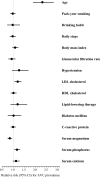Serum magnesium, phosphorus, and calcium levels and subclinical calcific aortic valve disease: A population-based study
- PMID: 29655832
- PMCID: PMC5991478
- DOI: 10.1016/j.atherosclerosis.2018.03.035
Serum magnesium, phosphorus, and calcium levels and subclinical calcific aortic valve disease: A population-based study
Abstract
Background and aims: Calcific aortic valve disease (CAVD) is the most common valve disease. Although micronutrients are known to contribute to cardiovascular disease, the relationship with CAVD remains poorly evaluated. We examined the association of serum levels of magnesium, phosphorus, and calcium with prevalence, incidence, and progression of aortic valve calcification (AVC).
Methods: We conducted a prospective study in a population-based sample of Japanese men aged 40-79 years without known cardiovascular disease and chronic kidney disease at baseline, and quantified AVC from serial computed tomographic images with the Agatston method.
Results: Of 938 participants at baseline (mean age, 63.7 ± 9.9 years), AVC prevalence was observed in 173 (18.4%). Of 596 participants without baseline AVC at follow-up (median duration, 5.1 years), AVC incidence was observed in 138 (23.2%). After adjustment for demographics, behaviors and cardiovascular risk factors, relative risks (95% confidence intervals) in the highest versus lowest categories of serum magnesium, phosphorus, and calcium were 0.62 (0.44-0.86), 1.45 (1.02-2.04), and 1.43 (0.95-2.15), respectively, for AVC prevalence and 0.62 (0.42-0.92), 1.93 (1.28-2.91), and 1.09 (0.77-1.55), respectively, for AVC incidence. Their linear trends of serum magnesium and phosphorus were also all statistically significant. Of 131 participants with baseline AVC, there was no association of any serum micronutrients with AVC progression.
Conclusions: Serum magnesium was inversely associated, while serum phosphorus was positively associated with AVC prevalence and incidence, suggesting that these serum micronutrients may be potential candidates for risk prediction or prevention of CAVD, and warranting further studies.
Keywords: Aortic valve disease; Calcification; Epidemiology; Magnesium; Phosphorus; Prospective study.
Copyright © 2018 Elsevier B.V. All rights reserved.
Conflict of interest statement
The authors declared they do not have anything to disclose regarding conflict of interest with respect to this manuscript.
Figures


Comment in
-
Cardiovascular calcification: The emerging role of micronutrients.Atherosclerosis. 2018 Jun;273:119-121. doi: 10.1016/j.atherosclerosis.2018.04.019. Epub 2018 Apr 20. Atherosclerosis. 2018. PMID: 29705018 No abstract available.
Similar articles
-
Lipoprotein(a) Levels Are Associated With Subclinical Calcific Aortic Valve Disease in White and Black Individuals: The Multi-Ethnic Study of Atherosclerosis.Arterioscler Thromb Vasc Biol. 2016 May;36(5):1003-9. doi: 10.1161/ATVBAHA.115.306683. Epub 2016 Mar 3. Arterioscler Thromb Vasc Biol. 2016. PMID: 26941019 Free PMC article.
-
Serum phosphate is associated with aortic valve calcification in the Multi-ethnic Study of Atherosclerosis (MESA).Atherosclerosis. 2014 Apr;233(2):331-337. doi: 10.1016/j.atherosclerosis.2013.12.051. Epub 2014 Jan 21. Atherosclerosis. 2014. PMID: 24530958 Free PMC article.
-
Oxidized Phospholipids and Calcific Aortic Valvular Disease.J Am Coll Cardiol. 2024 Dec 17;84(25):2430-2441. doi: 10.1016/j.jacc.2024.08.070. Epub 2024 Nov 15. J Am Coll Cardiol. 2024. PMID: 39545902
-
Sex-specific differences in age-related aortic valve calcium load: A systematic review and meta-analysis.Ageing Res Rev. 2020 Aug;61:101077. doi: 10.1016/j.arr.2020.101077. Epub 2020 Apr 22. Ageing Res Rev. 2020. PMID: 32334093
-
Calcific aortic valve disease: is it another face of atherosclerosis?Indian Heart J. 2015 Sep-Oct;67(5):503-6. doi: 10.1016/j.ihj.2015.07.033. Epub 2015 Aug 21. Indian Heart J. 2015. PMID: 26432749 Free PMC article. Review.
Cited by
-
Hyperphosphatemia is associated with cardiac valve calcification in chronic hypoparathyroidism.J Endocrinol Invest. 2022 Jul;45(7):1359-1366. doi: 10.1007/s40618-022-01770-1. Epub 2022 Mar 2. J Endocrinol Invest. 2022. PMID: 35235195
-
Dysmagnesemia Is the Most Common Disturbance of the Calcium-Magnesium-Phosphorous Balance among Older Hospitalized People in Warsaw.Nutrients. 2021 Sep 27;13(10):3395. doi: 10.3390/nu13103395. Nutrients. 2021. PMID: 34684395 Free PMC article.
-
Higher serum phosphate within the normal range is associated with the development of calcified aortic valve disease.Front Cardiovasc Med. 2024 Sep 26;11:1450757. doi: 10.3389/fcvm.2024.1450757. eCollection 2024. Front Cardiovasc Med. 2024. PMID: 39399509 Free PMC article.
-
Heart Rate Fragmentation, Ambulatory Blood Pressure, and Coronary Artery Calcification: A Population-Based Study.JACC Asia. 2023 Dec 5;4(3):216-225. doi: 10.1016/j.jacasi.2023.10.004. eCollection 2024 Mar. JACC Asia. 2023. PMID: 38463673 Free PMC article.
-
A Rat Model with Multivalve Calcification Induced by Subtotal Nephrectomy and High-Phosphorus Diet.Kidney Dis (Basel). 2020 Sep;6(5):346-354. doi: 10.1159/000506013. Epub 2020 Jul 10. Kidney Dis (Basel). 2020. PMID: 33490114 Free PMC article.
References
-
- Rajamannan NM, Moura L. The lipid hypothesis in calcific aortic valve disease: The role of the Multi-Ethnic Study of Atherosclerosis. Arterioscler Thromb Vasc Biol. 2016;36:774–776. - PubMed
-
- Rajamannan NM, Evans FJ, Aikawa E, Grande-Allen KJ, Demer LL, Heistad DD, Simmons CA, Masters KS, Mathieu P, O'Brien KD, Schoen FJ, Towler DA, Yoganathan AP, Otto CM. Calcific aortic valve disease: Not simply a degenerative process: A review and agenda for research from the national heart and lung and blood institute aortic stenosis working group. Executive summary: Calcific aortic valve disease-2011 update. Circulation. 2011;124:1783–1791. - PMC - PubMed
-
- Otto CM, Lind BK, Kitzman DW, Gersh BJ, Siscovick DS. Association of aortic-valve sclerosis with cardiovascular mortality and morbidity in the elderly. N Engl J Med. 1999;341:142–147. - PubMed
-
- Saikrishnan N, Kumar G, Sawaya FJ, Lerakis S, Yoganathan AP. Accurate assessment of aortic stenosis: A review of diagnostic modalities and hemodynamics. Circulation. 2014;129:244–253. - PubMed
Publication types
MeSH terms
Substances
Supplementary concepts
Grants and funding
LinkOut - more resources
Full Text Sources
Other Literature Sources

